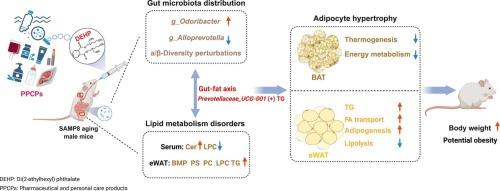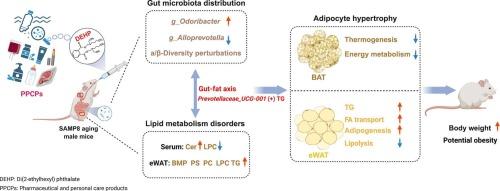环境暴露于邻苯二甲酸二(2-乙基己基)通过肠道脂肪轴加速雄性SAMP8小鼠的脂质代谢紊乱:肠道微生物群和甲状腺激素信号的作用
IF 9.7
1区 环境科学与生态学
Q1 ENVIRONMENTAL SCIENCES
引用次数: 0
摘要
邻苯二甲酸二(2-乙基己基)酯(DEHP)是一种广泛使用的环境内分泌干扰物和潜在的致肥物质。它在医药和个人护理产品(PPCPs)中的普遍存在,以及相关的生态和健康风险,引起了越来越多的科学关注。基于我们之前的发现,DEHP暴露与老年人肥胖风险增加有关,本研究调查了DEHP对衰老过程中脂肪组织脂质代谢的影响。雄性衰老加速倾向(SAMP8)小鼠口服DEHP(0、0.2或200 mg/kg/天)5周。DEHP暴露显著增加体重并诱导脂肪细胞肥大,特别是在较低剂量下。它还抑制了全身能量代谢,损害了棕色脂肪组织(BAT)的产热功能。在附睾白色脂肪组织(eWAT)中,DEHP促进脂质积累并破坏脂质组学谱。此外,DEHP改变了肠道菌群组成,降低了α-和β-多样性,并显著增加了Prevotellaceae_UCG-001的丰度,这与eWAT中甘油三酯水平升高呈正相关。同时,DEHP暴露下调脂肪组织中去碘酶和甲状腺激素受体的mRNA和蛋白表达,表明局部甲状腺激素信号通路受到抑制。总之,这些发现表明,DEHP暴露通过肠道微生物群失调和甲状腺激素信号受损介导的肠脂肪轴的改变来破坏脂质代谢,最终导致衰老SAMP8小鼠的肥胖发展。本文章由计算机程序翻译,如有差异,请以英文原文为准。


Environmental di-(2-ethylhexyl) phthalate exposure accelerates lipid metabolism disorders via the gut-fat axis in male SAMP8 mice: role of gut microbiota and thyroid hormone signaling
Di-(2-ethylhexyl) phthalate (DEHP) is a widely used environmental endocrine disruptor and a potential obesogen. Its pervasive presence in pharmaceutical and personal care products (PPCPs), along with the associated ecological and health risks, has attracted growing scientific concern. Building on our previous findings linking DEHP exposure to an increased risk of obesity in elderly humans, this study investigated the effects of DEHP on lipid metabolism in adipose tissue during aging. Male senescence-accelerated prone (SAMP8) mice were orally administered DEHP (0, 0.2, or 200 mg/kg/day) for five weeks. DEHP exposure significantly increased body weight and induced adipocyte hypertrophy, particularly at the lower dose. It also suppressed systemic energy metabolism and impaired thermogenic function in brown adipose tissue (BAT). In epididymal white adipose tissue (eWAT), DEHP promoted lipid accumulation and disrupted lipidomic profiles. Moreover, DEHP altered gut microbiota composition, reducing α- and β-diversity, and notably increasing the abundance of Prevotellaceae_UCG-001, which was positively correlated with elevated triglyceride levels in eWAT. Concurrently, DEHP exposure downregulated the mRNA and protein expression of deiodinases and thyroid hormone receptors in adipose tissues, indicating suppression of local thyroid hormone signaling. Taken together, these findings demonstrate that DEHP exposure disrupts lipid metabolism via alterations in the gut-fat axis, mediated by gut microbiota dysbiosis and impaired thyroid hormone signaling, ultimately contributing to obesity development in aging SAMP8 mice.
求助全文
通过发布文献求助,成功后即可免费获取论文全文。
去求助
来源期刊

Environment International
环境科学-环境科学
CiteScore
21.90
自引率
3.40%
发文量
734
审稿时长
2.8 months
期刊介绍:
Environmental Health publishes manuscripts focusing on critical aspects of environmental and occupational medicine, including studies in toxicology and epidemiology, to illuminate the human health implications of exposure to environmental hazards. The journal adopts an open-access model and practices open peer review.
It caters to scientists and practitioners across all environmental science domains, directly or indirectly impacting human health and well-being. With a commitment to enhancing the prevention of environmentally-related health risks, Environmental Health serves as a public health journal for the community and scientists engaged in matters of public health significance concerning the environment.
 求助内容:
求助内容: 应助结果提醒方式:
应助结果提醒方式:


